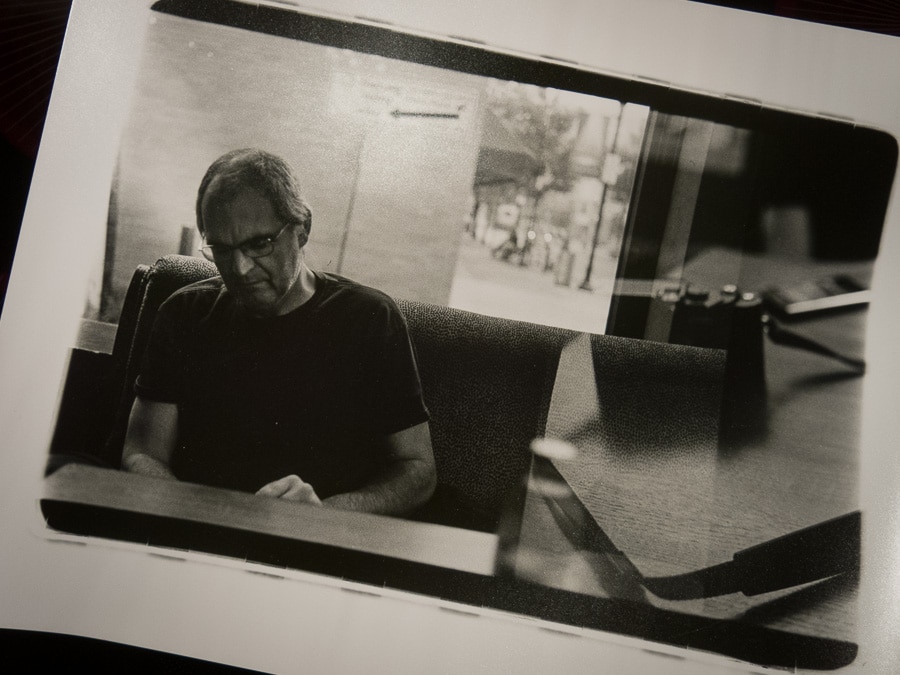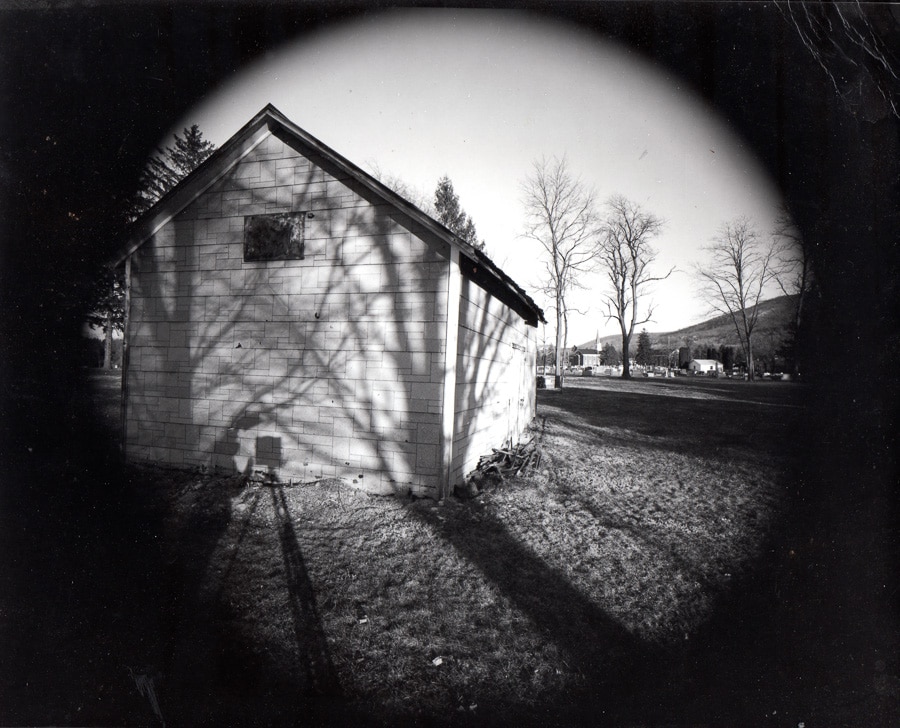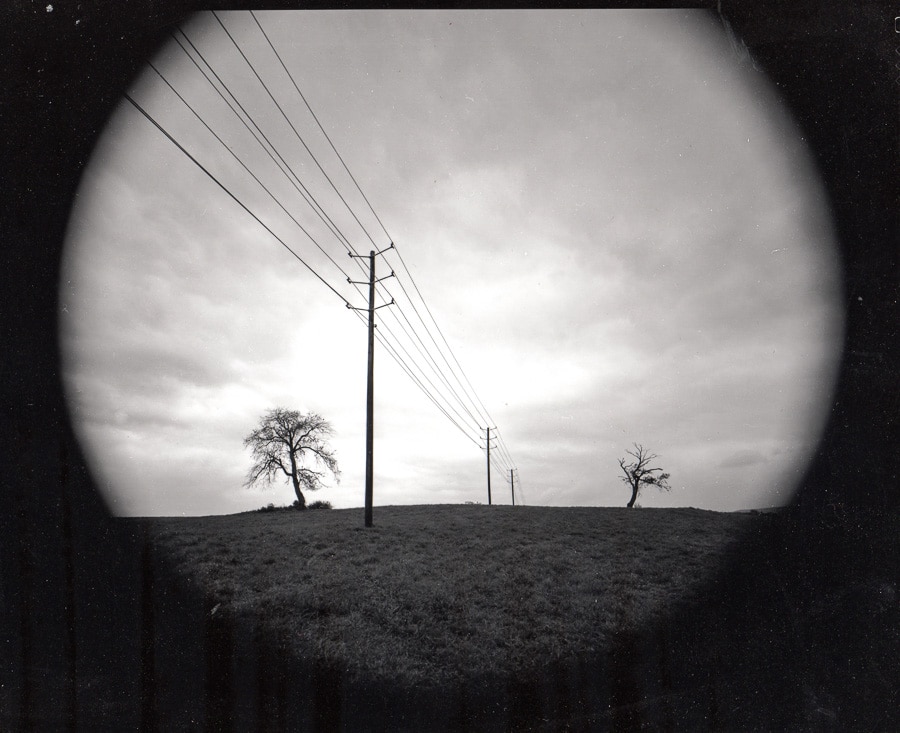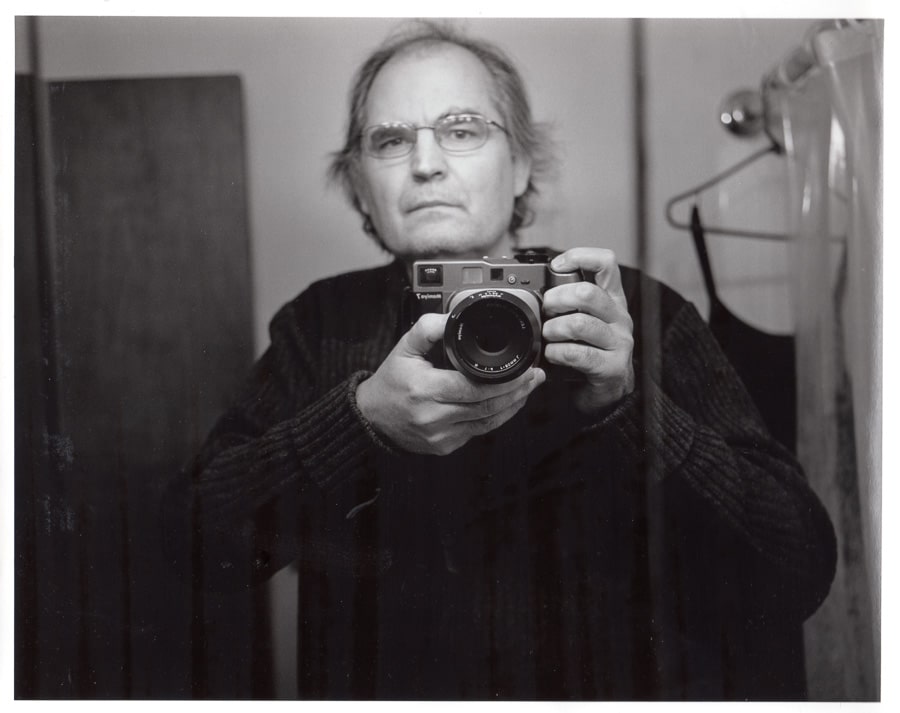 Photographic History
Photographic History
Before the Vespa scooter, before marriage and children and Belgian Sheepdogs there was photography. Like the love of chocolate and a draw to the outdoors photography has been a constant companion. Looking through a box of prints and contact sheets is like walking a trail of personal photographic history; an illustrated story of where I’ve been. The prints also mark an end of a photographic life — the moment in time when film gave way to digital capture of images. The film vs. digital photography discussions are as boring as which motorcycle or scooter is best. There is no answer, only utility and preference at any given moment.
My friend and photographer Gordon Harkins made the picture of me at Saint’s Cafe on one of our Sunday morning meetings to share prints and discuss projects. I don’t remember whether the juxtaposition of me with my Leica M6 was the result of an odd reflection or a double exposure. It does “feel” like those times.
 Photography in the 1980s
Photography in the 1980s
I can’t remember who made this photograph. My guess is a self portrait because the camera was seldom turned my way by anyone else. It’s odd to look at now as I try to bridge a gap of perhaps 35 years. I recognize the Domke bag over my shoulder, the bright red wool Boy Scout shirt by father-in-law gave me, the white tennis shoes I always wore. An expensive home sits in this field now. The alfalfa replaced by a sweeping desert landscape of turf and artfully placed trees.
Photography was how I earned a living then. Any use of it as a means of personal expression was still ahead. I was fascinated by expanding technical skills and acquiring equipment. I was approaching the height of my work with ad agencies and corporate annual reports.
I was a hired gun.
 Enter the View Camera
Enter the View Camera
A view camera is a heavy, slow, plodding device. Not unlike a Harley Davidson motorcycle. But it’s nature holds unique power to pull you off life’s treadmill and lead you to a different way of surviving until it changes the way you live and see the world.
A couple years before I purchased my first Vespa scooter I was using an 8×10 Zone VI view camera with a heavyweight wooden tripod. With lens, film holders and other minor accessories it was a ponderous load to use and carry. Photographically, from a technical perspective, the large format negatives make stunningly crisp, almost luminous silver prints. I was seduced by these traits independent of image content. Over time though, a more important power emerged from this graceless beast — the ability to slow down time.
The image of the old, InselBrick sided garage was photographed using a lens that couldn’t cover the entire piece of 8×10 film yielding a circular image. I experimented with this point of view for a long time as I wondered about what I was seeing. This view looks across the cemetery in Boalsburg, Pennsylvania toward the Zion Lutheran Church.
 Noticing the World
Noticing the World
These intertwined tree trunks have posed for me dozens of times over the last 25 years. The symbolism of my marriage is not lost on me as I have watched them through the seasons grow and age. The small details all around and my ability to see them has driven my photographic practice and how I process my life. It started with the view camera experimentation and continues as I work digitally. My goal has never been to travel to majesty, but rather see it all around.
 Searching for Meaning
Searching for Meaning
There’s a thread running through most of the images I make — I’m searching for meaning or understanding. All those “WHY” questions that some say are best left to God. Still they echo through my head, sometimes quietly and sometimes in a howl. While riding the journey can often be divided into two distinct categories; the quiet ride that’s a flight of physical pleasure and mental quiet. And the other, an ongoing conversation of the significance of what I’m seeing and feeling. The camera helps manage that conversation.
Looking at this photograph I still wonder why I made a decision on that day to haul the view camera out of the truck and carry it to this location. Years later I see a scooter ride through the central Pennsylvania landscape. Perhaps it was a fortune telling of things to come.
 Photographic Themes
Photographic Themes
This 8×10 contact print echoes a theme that flows through much of the imagery I create and post on Scooter in the Sticks — the empty landscape devoid of people or vehicles. The empty places I’m drawn to over and over again.
This scene is three miles from my doorstep but it’s an illusion of the place. I’m reminded of the lies photographs tell and the warning viewers should heed of everything they see. The photographer is a magician and the choices which render how something is seen — what’s included and excluded — affects the story.
With this photo if you stood in this place this is exactly what you would see. Behind me at some distance is a sprawling housing development. Just over the rise is a highway and shopping center and off to the left another highway and housing development.
My photographs reflect what I need to see. In a busy, chaotic day, it’s nice to imagine a serene place.
 Film vs. Digital
Film vs. Digital
Before cellphone selfies were the pictures in the mirror, reflections of the photographer in myriad places, all made in hopes of discovering something about myself. I see my father, the passage of time, a heart attack, a grandfather, someone who wants to ride a scooter. I know a lot of people who only see fear in the mirror but I’ve always felt it’s a test of my ability to acknowledge the nature of the ride I’m on.
And the ride eventually ends.
Questions of film vs. digital are irrelevant — only the image matters and what I’m trying to understand or say. It’s been a passenger on the ride for a long time and hopefully will be with me for many more miles.
Keep your camera close.
Powerful post Steve!
I like that picture of your younger self…..roguish photo-adventurer?
Not sure I was an adventurer but I did move through the world with a camera. Back then I was a Nikon man shooting with F3 and FM2 cameras. Hauled a lot of stuff around on my shoulder back then.
A good post that inspired me to rummage through a couple of old boxes of my own negatives and prints. After all of the years, I still keep the camera close. The camera might be an iPhone, but making images is still exciting. I still break out the film camera from time to time for some fun and to practice manual focusing.
There are clues and reminders of the life we’re part of in those boxes. I always enjoy looking through them.
There are cameras that I miss and others there’s no connection at all. Sometimes it’s the process they enforced and others are memories of their use. Both of my Zone VI view cameras and my Leica M6 stand out in my mind. And sadly, all gone. Kim tells me not to worry though, I can always buy another…
Steve, I find your post, for a lack of a better word, soothing, in each of their own special ways. I enjoy starting my morning with them. They warm me up as a good cup of coffee.
May I ask what camera do you use now for your stories? Do you use software to correct them (if so which one) or do you let them stand on their own merits.
Thanks. Al
Thanks for the kind words about the post. Glad it helped launch your morning.
The majority of the images for the blog over the past couple years were made with a Canon G15. It’s a high end point and shoot camera. I almost always manually set shutter speed and exposure depending on what I’m trying to achieve. I have the camera set to produce RAW files which I process in Adobe Lightroom and export as JPEGs for upload.
I don’t do much processing — tweak the exposure, color balance, vibrance and sometimes crop a little. Sharpening of the image is automated by Lightroom on export. But not much more than that.
Those are some great, old photographs, Steve–enhanced and given context by your fine, recollective narrative, of course.
I’m impressed by your remarks about what isn’t seen in photographs: Oh, the secrets photographer keeps–the illusionist the photographer is. Indeed, what’s behind or over the horizon or otherwise out of frame does not matter–an analogy for living in the moment, for being present?…
I think about a photo I took a few years back on a return trip across the barren desert from eastern Nevada. The subject is a desolate, dirt road stretching ahead apparently endlessly, and at the bottom of the frame are the instruments on my GS and the GS’s right mirror, reflecting my camera-obscured, helmeted face and, behind me, power lines in the sky.
Short of the motorcycle, those power lines are the only in-frame evidence of modernity, of civilization, evidence of the rural highway I’d just left. For that very reason, that photo both bothers me and intrigues me.
Thanks for the kind words Ry. Always nice to reminisce through old photos.
As far as what’s seen and not seen in photos, one thing I’ve learned is that they’re are far more complicated than they appear and both maker and viewer bring a lot of baggage to the the moment. The photo you describe is an example of the unique experience we bring to an image. I always feel good when I learn a photo makes someone move, squirm or react…
Oooh, love that s/p with the Mamiya 7!
I still mostly shoot film…35mm is truly my “home” format, and until my mystical ship comes in allotting me with a pair of full-frame Leicas or the like, that’s how it’ll stay. However, I’ve also made my peace with digital over the last six years, with a decent compact camera of some sort or other, and now have inherited a dSLR from Sig. Other (Nikon D300, old but solid, and her mainstay until she moved to a D800 a few years back). The thing is, I got sick to the teeth with SLRs of all stripes nearly fifteen years back, and moved to a rangefinder setup (pair of Konica Hexar RFs and trio of lenses), and never looked back.
On the “stuff that isn’t seen” in pictures, I think about what I didn’t notice at the moment of exposure…or even the stuff I didn’t notice the first time I made a print. This is where things like contact sheets have become invaluable. (While I’ve continued to shoot on film, I pretty much gave up the “analog” darkroom back in 1997: bought a good film scanner, a good flatbed scanner to make digital contact sheets on, and Epson’s first 13-inch format photo printer…and, again, never looked back.) I never got into the edit-in-the-field mentality a lot of people seemed to develop when transitioning to digital cameras – there’s even more that you don’t see in that little image on the back screen. I never know about an image until it’s writ large, or large-ish…in a print, or at least on a 23-inch screen. And, even then, like Garry Winogrand, I might want to sit on that image a while, before I look at it again, which is usually a while before anyone else gets a look.
Sometimes this process can be a bit rough, as I think of photography in terms of heart-and-head, or heart-vs.-head, and the way I look at an image taken decades ago gets turned on its head.
(Sig. Other is beckoning me to grab a camera now…pink skies everywhere before dusk.)
I imagined the Mamiya 7 to be like my Leica M6 on steroids. Sadly that wasn’t the case and I never warmed to the camera.
Contact sheets are what I miss most about film photography. I LOVED looking through 35mm sheets. I know I can see everything in Lightroom, and larger and clearer, but there was a mystery that was special in print. And you could get the feeling for an entire roll in a glance. Doesn’t happen the same in Lightroom.
My early relationship with photography is both extremely significant, and completely different.
My Dad worked all his life for Kodak. We took family vacations to places like the 1964 New York World’s Fair, and Washington D.C. and his job gave us special access to amazing places behind the scenes like the film warehouse at the headquarters of the National Geographic Society. I remember towering shelving in a huge temperature-controlled vault with what seemed like thousands and thousands of yellow Kodak boxes.
My childhood was intensely documented in dozens and dozens of Kodachrome Carousel slide trays.
My sister took them and had the collection digitized. I haven’t gotten around to getting the DVDs from her. It’s something I need to do.
Kodak was magic to me growing up. The big yellow box was everywhere and when I started to process my own stuff I entered a Kodak world of names and products that just made me feel special. Medalist and AZO papers, Dektol, D-76, DK-50, Kodalith, and on and on. And the films and contains — Kodak was on top of everything. What the heck happened…
I had hours and hours of 8mm movies transferred to video. I neglected to break out the record tabs. My daughter recorded Saturday morning cartoons over them…
Photography, an adjunct to life, for me. Started as many do with a Brownie Kodak, 620 film. It of course was a 1/50th shutter speed. So for me it would not stop a moving train (which was and still is my first hobby) however it would allow photographs of stationary railway related objects. Still have all of those negatives, carefully catalogued. And these days the negatives are scanned, and then printed, all dry, no wet process involved.
Had a quick look, first photographs taken in March of 1953 or so. I would have been
in my eighth year. And some 62 years later still take photographs of railways. Although the political atmosphere has drastically changed. Police are always wondering why we
of the hobby photograph trains and their ilk.
The freedom you and I experienced in our youth Steve, is gone forever.
Which is what outside forces want to happen; so we feel “their” pain of being always under the gun so to speak.
Think too of the physical devices for photography. like you once a field camera, and a latterly Speed Graphic . And too still have a field camera, a Toyo, acquired from an estate sale, in lovely condition. Thankfully the addition of different lens boards allows the use of both the Kodak and Wolensak convertible lenses. And the joy of knowing I have three film holders each with two sheets of film. These days it is processing that is difficult. Use a small private lab about twenty miles from here; he does the processing once a month, in batches. I receive a copy print and a negative in a sleeve, in return for $8.00 cash per negative. Cash eliminates the 13 percent sales tax.
Then I look at my metal slide boxes, 25 thousand plus colour slides, not all Kodak either. Perutz, Agfa, they all produced films for colour slides, once. Also have a certain amount of black and white slides, from glass plate negatives. All in the sorting process.
If I expire, want to see some of my historical images to go to the local Historical Society, rather than the dumpster. My living Will details all of the this….
Bottom line, iti s a hobby. Oh, and when we were both younger we thought nothing of carrying those heavy photographic devices everywhere. I used Hasselblads as my then employer used them, I initially used Pentax then Nikon and in between the aforementioned large format cameras, a number of Rolliflexes as well as myriad other brands. Exacta comes to mind.
Now the method of rendering the image has changed, and sadly said image exists only in zeros and ones; and until printed exists only on a computer disk that has not yet failed.
The images worth keeping are printed, labelled, andp laced in a dark place. BTW colour lasts maybe 200 years, black and white as there is no “colour” could last forever.
Neither one of us will be here forever so we won’t know if this is true, or not.
So many of us started out like you Bryce — some small Kodak camera to explore with and moving on to hobbyist. Lots of people photograph trains around here especially at the Horseshoe Curve, Tunnel Hill and a host of other locations. I’ve never had the police interfere but I suspect if I were photographing bridges they might. The world is changing.
I still have a 4×5 Speed Graphic is near mint condition. Hardly even think about it. My first view camera was a small Century Graphic with a 120 roll back. Loved that camera. Could shoot 2-1/4 x 3-1/4 sheet film with it too. Kodak sold that size. Now I would probably have to cut down larger sheets.
I do worry about archiving digital images. I have seven external hard drives next to the computer with a really messy system of back up. Will take months to sort things out. Maybe it doesn’t matter. Who knows what will happen to my work when I’m gone.